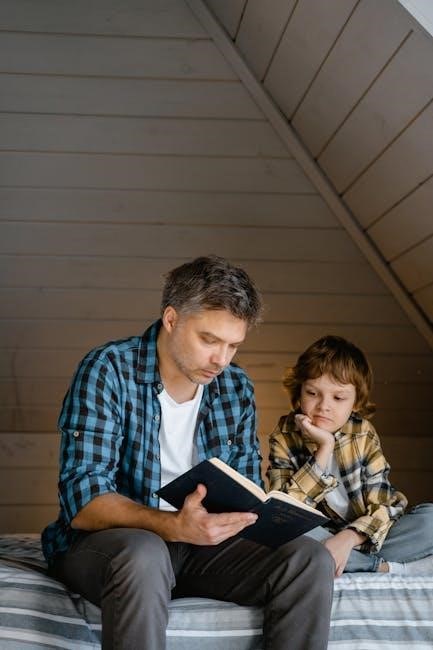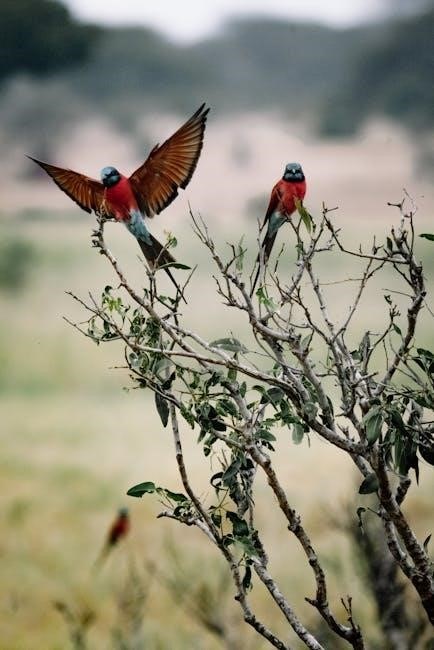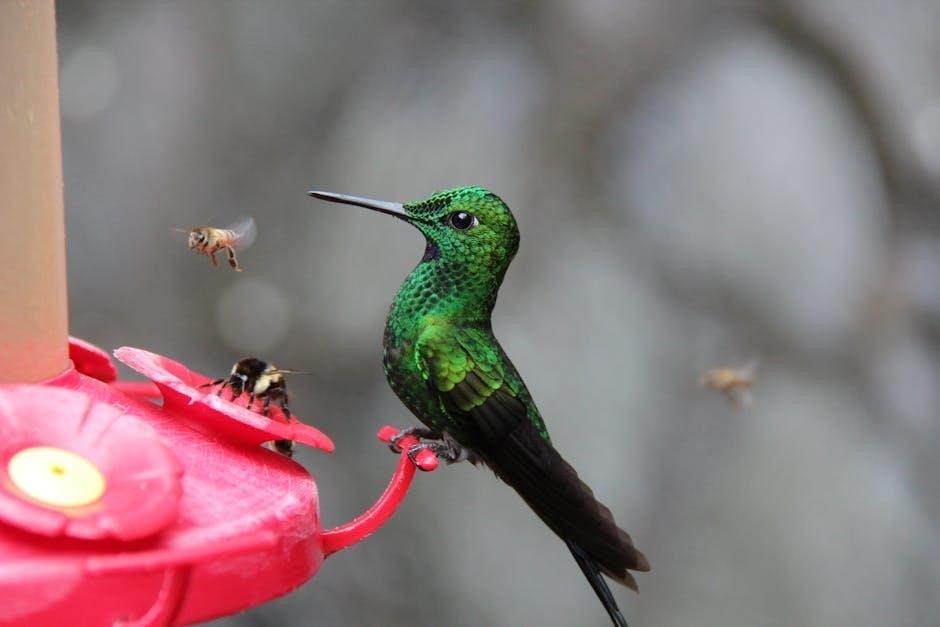
birds and the bees story pdf
The Birds and the Bees Story: A Comprehensive Guide

The birds and the bees, a timeless phrase, serves as a metaphorical explanation of reproduction and relationships. This guide explores the phrase’s origin, evolution, and cultural significance. Understanding its history enriches conversations about this essential topic, particularly when discussing it with children.
Origin and Evolution of the Phrase

The exact origin of “the birds and the bees” remains somewhat hazy, though it likely emerged in the early 20th century. While the phrase seems ancient, its use as a metaphor for explaining sexual reproduction to children is more recent. Long before its explicit use, birds and bees were commonly paired in literary allusions. The Indianapolis Journal mentioned in 1887 that “the birds and the bees” was a metaphorical story told to children, referencing natural events like bees carrying pollen and birds laying eggs, paralleling fertilization.
One early association comes from John Evelyn’s diary in 1644, describing decorations in St. Peter’s Cathedral with cherubs, birds, and bees, possibly combining human sexuality imagery with nature. Samuel Taylor Coleridge’s 1825 poem, “Work without Hope,” also links nature’s activity with the stirring of life, further cementing the connection between birds, bees, and themes of renewal and reproduction. The phrase gained popularity as a euphemism, carefully avoiding explicit details while conveying the essentials of reproduction.
Early Literary Allusions: Birds and Bees in Context
Before becoming a common euphemism, birds and bees frequently appeared in literature, symbolizing nature, spring, and the interconnectedness of life. These early allusions laid the groundwork for the phrase’s later use in explaining reproduction. Poets and writers often paired these creatures to evoke images of blossoming flowers, buzzing activity, and the cycle of life.
Samuel Taylor Coleridge’s poem “Work without Hope” serves as a prime example. His verses capture the essence of nature awakening, with bees stirring and birds taking flight, alluding to the vibrant energy of spring. While not explicitly about reproduction, the poem establishes a strong link between birds, bees, and the renewal of life, a theme closely associated with the concept of procreation.
These literary pairings provided a cultural backdrop, allowing the phrase “the birds and the bees” to evolve into a gentle, metaphorical way of introducing children to the complex realities of reproduction, drawing on familiar and innocent images from the natural world.
Samuel Taylor Coleridge’s Influence
Samuel Taylor Coleridge’s contribution to the “birds and the bees” narrative is significant, though indirect. His 1825 poem, “Work without Hope,” is often cited as an early connection between these creatures and themes of vitality and natural processes. The poem’s imagery of stirring bees and birds in flight, all amidst a landscape awakening from winter, subtly links these elements to the broader concept of life’s renewal.
Coleridge’s verses paint a picture of nature in motion, hinting at the underlying forces that drive growth and reproduction. While not explicitly discussing sex or procreation, the poem’s evocative language creates an association between birds, bees, and the vibrant energy of spring, a season traditionally linked to fertility.
This association, though subtle, helped pave the way for the later use of “the birds and the bees” as a euphemism for explaining reproduction to children. By associating these creatures with the general concept of life and its renewal, Coleridge’s work contributed to the cultural context in which the phrase could eventually take on its more specific meaning.
John Evelyn’s Diary: An Indirect Reference?
John Evelyn’s 1644 diary entry is considered one of the earliest, albeit indirect, references that may have contributed to the development of the “birds and the bees” metaphor. Evelyn described a visit to St. Peter’s cathedral in Rome, focusing on its ornate canopy. He noted the presence of “putti cherubs, birds and bees” amidst the vines and columns.
While not explicitly linked to reproduction, this combination of imagery – cherubs (often associated with innocence and new life), birds, and bees – presented a suggestive tableau. Finegan interprets the passage as combining human sexuality with the natural imagery of birds and bees.
It’s important to note that Evelyn’s diary entry wasn’t a direct discussion of sex or reproduction. However, the juxtaposition of these elements within a single visual description may have planted a seed in the cultural consciousness. The diary entry illustrates how birds and bees were already being associated with themes of vitality and decoration, setting the stage for their later use as a euphemism for more sensitive subjects.
The Simpsons’ Satirical Take
The Simpsons, known for its sharp wit and cultural commentary, offered a satirical take on the “birds and the bees” concept in a 1995 episode. This comedic approach highlights the phrase’s established place in popular culture and its potential for humorous subversion.
The episode likely played on the traditional, often awkward, way the “birds and the bees” talk is delivered to children. By exaggerating or misinterpreting the metaphor, The Simpsons poked fun at the euphemistic nature of the phrase and the challenges of explaining complex topics to young audiences.
The show may have depicted a character, such as Bart Simpson, receiving the “birds and the bees” talk in a particularly absurd or misguided way. This satirical portrayal underscores the potential for miscommunication and misunderstanding surrounding the topic of reproduction. The Simpsons’ take demonstrates the phrase’s cultural saturation and how it can be used for comedic effect, reflecting societal anxieties and discomfort surrounding sex education.
Meaning and Usage: Explaining Reproduction
The core meaning of “the birds and the bees” lies in its function as a metaphor for explaining reproduction, particularly to children. It relies on imagery from nature—bees pollinating flowers and birds laying eggs—to represent the biological processes of fertilization and birth.
This euphemistic approach aims to simplify complex concepts, making them accessible to young minds without being overly explicit or graphic. The phrase allows parents and educators to introduce the topic of reproduction in a gentle and age-appropriate manner.
The “bees” represent the transfer of pollen, analogous to fertilization, while the “birds” laying eggs symbolize the process of gestation and birth. This natural imagery provides a relatable and less intimidating way to discuss the origins of life. However, the effectiveness of this metaphor depends on the child’s understanding of basic biological concepts. The phrase serves as a starting point for further discussion.
The Birds and the Bees as a Metaphor for Nature and Spring

Beyond its association with reproduction, “the birds and the bees” also functions as a broader metaphor for the natural world, particularly in the context of spring. The phrase evokes images of renewal, growth, and the flourishing of life after winter’s dormancy.
Bees, actively gathering pollen, symbolize the industriousness of nature, while birds, returning from migration and building nests, represent new beginnings. The phrase captures the vibrancy and energy of spring, a time when life is visibly abundant.
This metaphorical connection to nature and spring likely predates its specific association with reproduction. The observation of bees pollinating flowers and birds engaging in courtship rituals has long been associated with the cycle of life and the reawakening of the natural world. The phrase encapsulates the interconnectedness of all living things and the cyclical nature of existence.
Cultural Significance and Impact
The phrase “the birds and the bees” holds significant cultural weight as a euphemistic way to introduce the topic of reproduction to children. It represents a societal approach to delicate subjects, often characterized by indirectness and a reliance on natural imagery.
The impact of this phrase extends beyond simple explanation. It reflects cultural values regarding sexuality, innocence, and the appropriate timing for such discussions. The phrase has shaped how generations have approached the subject of reproduction, often serving as a rite of passage into understanding the complexities of life;
Its persistence in language and popular culture underscores its enduring relevance. While modern approaches to sex education may be more direct, “the birds and the bees” remains a recognizable and culturally significant phrase. It serves as a reminder of evolving attitudes toward sexuality and the ongoing need for open and honest communication.
Age-Appropriate Tips for “The Talk”
When approaching “the talk,” tailoring the information to your child’s age is crucial. For younger children, focus on basic concepts like how animals reproduce, using imagery of bees pollinating flowers or birds laying eggs. Avoid overwhelming them with details they aren’t ready for.
As children get older, gradually introduce more complex information about human reproduction. Be honest and open, but avoid being overly graphic. Use accurate terminology, but explain it in a way they can understand.
Create a safe and comfortable environment for questions. Encourage your child to ask anything they’re curious about. If you don’t know the answer, be honest and offer to find out together; Remember, the goal is to provide accurate information and foster open communication about sexuality as they grow.
Modern Interpretations and Relevance
In today’s world, the “birds and the bees” conversation has evolved beyond a simple explanation of reproduction. Modern interpretations emphasize consent, healthy relationships, and responsible decision-making. It’s crucial to discuss these aspects alongside the biological facts.
The relevance of this conversation remains significant. Children are exposed to various sources of information, some of which may be inaccurate or inappropriate. Providing accurate, age-appropriate information empowers them to make informed choices and navigate relationships safely.
Furthermore, modern discussions often include topics like gender identity, sexual orientation, and body positivity. These conversations promote inclusivity and acceptance. By addressing these topics openly, parents and educators can create a supportive environment where children feel comfortable asking questions and expressing themselves.
Related Idioms and Euphemisms
The phrase “birds and the bees” exists within a broader landscape of idioms and euphemisms used to discuss sensitive topics like sex and reproduction. Understanding these related expressions can provide context and nuance to conversations.
Some common euphemisms include “making babies,” “sleeping together,” and “getting intimate.” These phrases often serve as indirect ways to refer to sexual activity, particularly in polite or formal settings.
Other related idioms touch on different aspects of relationships and courtship. “Falling in love,” “tying the knot,” and “starting a family” all evoke images of romance, commitment, and domesticity.
Exploring these related terms can help individuals navigate conversations about sex and relationships with greater sensitivity and awareness. It’s important to recognize that the choice of language can significantly impact the tone and message conveyed.
The Birds and Bees in Different Cultures
The concept of explaining reproduction to children through metaphors varies significantly across cultures. While “the birds and the bees” is a common idiom in English-speaking countries, other cultures employ different imagery and approaches.
In some cultures, natural phenomena like the blooming of flowers or the changing seasons are used to represent the cycle of life and reproduction. These metaphors often emphasize the beauty and wonder of nature.
Other cultures may rely on storytelling or traditional folklore to convey information about sex and relationships. These narratives often incorporate moral lessons and cultural values.
It’s important to recognize that cultural norms and beliefs shape how societies approach the topic of reproduction. Some cultures may be more open and direct, while others may prefer indirect or symbolic communication.
Resources for Parents and Educators

Navigating “the talk” can be challenging, but numerous resources are available to support parents and educators. Many organizations offer age-appropriate guides and materials on topics like puberty, sexual health, and relationships.
Websites like Planned Parenthood and the American Academy of Pediatrics provide comprehensive information and advice for parents. These resources often include tips on how to start conversations, answer difficult questions, and address common misconceptions.
For educators, organizations like the Sexuality Information and Education Council of the United States (SIECUS) offer curricula and training programs on comprehensive sex education. These programs emphasize accuracy, inclusivity, and age-appropriateness.
Books and videos can also be valuable tools for explaining reproduction and relationships. Look for resources that are tailored to different age groups and developmental stages.